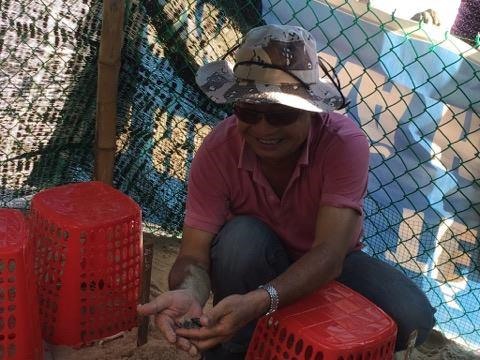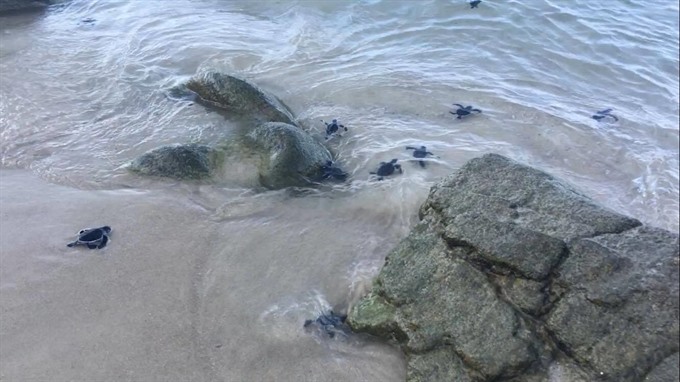 Environment
Environment

In a victory for turtle conservation efforts, about 421 baby turtles were released to the sea on Chàm Island yesterday.
 |
| Lê Xuân Ái, a researcher on the Chàm Island’s Marine Protected Area (MPA) management board, helps to release the first 182 endangered turtles to the sea off the Cham Island. — VNS Photo Nguyễn Thế Hùng |
In a victory for turtle conservation efforts, about 421 baby turtles were released to the sea on Chàm Island yesterday.
Their release continues the success of the first project in Việt Nam to release baby turtles far from the site where their eggs were laid—a practice known as ex-situ conservation—in order to repopulate turtle populations in areas where they have declined.
The turtles came from a batch of 450 eggs that were laid by turtles in five nests on Côn Đảo Island 50 days ago.
Lê Xuân Ái, a researcher on the Chàm Island’s Marine Protected Area (MPA) management board, told the Việt Nam News that 421 baby turtles out of 450 eggs hatched in sand nests on the island’s beaches, about 20km off the coast of Hội An. All swam well into the sea.
Ái said he and colleagues had moved the 450 eggs from Côn Đảo Island to the Chàm Island by cars, airplanes and train. The eggs’ long journey is part of a pilot project to restore the turtle population in central Việt Nam.
Because turtles usually return to the beach where they hatched when it’s time to lay their own eggs, the young turtles that swam away from the Chàm Island will likely remain in the area and return to spawn the next generation.
Ái said this is the first ever time ex-situ hatching had seen success in Việt Nam with 90 per cent of eggs hatching healthy baby turtles.
Ái, who chaired the project, said the turtle eggs had developed well in good weather in the Chàm Island.
“We are glad with the results of the pilot project on the Chàm Island this year. We hope that more eggs will be delivered to the sea later this year,” Ái said.
Ái said different scientific study programmes had been undertaken in the area for three years to ensure prolonged restoration of the endangered species.
He said the successful ex-situ conservation would encourage neighbouring coastal provinces to implement similar conservation plans.
Several beaches in central coastal Việt Nam, including Thừa Thiên-Huế, Đà Nẵng, Quảng Nam and Quảng Ngãi are favourite destinations for turtle reproduction. But rapid urban development, the speedy construction of beach resorts and hotels, the overexploitation of seafood and extensive pollution had destroyed their habitats. Ex-situ conservation could help rebuild turtle populations in the future.
Another batch of 450 eggs were also moved from Côn Đảo Island in the southern province of Bà Rịa-Vũng Tàu to the Chàm Island for a new hatching phase yesterday.
A final report on the first turtle egg hatching will be announced in October.
The Chàm Islands are home to 1,500ha of tropical forests and 6,700ha of sea. The area is home to a wide range of marine fauna and flora, including many endangered species such as swallows, the long-tailed monkey and the crab-eating macaque.
The 3,000 inhabitants of the islands, which include eight islets with vast ecological diversity, host around 100,000 tourists annually, of which 10 per cent are foreigners. The Chàm Island is a favourite tourism site along with the UNESCO-recognised Hội An ancient town and Mỹ Sơn Sanctuary. — VNS
 |
| The first baby turtles swim to sea on the Chàm Island, off the coast of Hội An City. These turtles were laid 50 days ago on Côn Đảo Island and were moved to the Chàm Island. — VNS Photo Nguyễn Thế Hùng |




